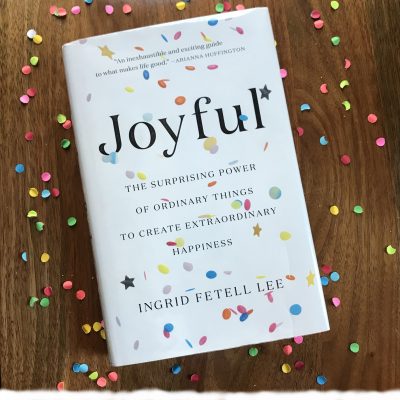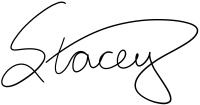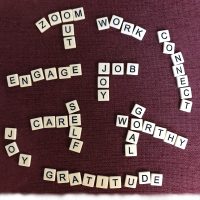Book Review: Joyful
by Ingrid Fetell Lee

20 February 2020 | Theme: Joy | 5-Minute Read | Listen
When designer Ingrid Fetell Lee stood before a panel of professors for her first review in the industrial design program, several of her creations on the table beside her, she watched their faces nervously, awaiting a verdict that would tell her whether she even belonged in design school. Finally, one professor said, “Your work gives me a feeling of joy.”
This led her to wonder: how can a simple object elicit joy?
We know instinctively that our spirits feel uplifted when we see a beautiful sunset. We take flowers or balloons when we visit people in hospitals. And a handful of confetti makes a gathering feel like a celebration. But why? If it’s true that joy is within us and not outside us, why do certain things help us to feel more joyful?
These are the questions Lee asked herself, so she began to study joy. Discovering that certain qualities in the world around us do stimulate feelings of joy, she identified ten “aesthetics of joy.” These ten aesthetics make up the chapters of her book Joyful: The Surprising Power of Ordinary Things to Create Extraordinary Happiness:
Energy: vibrant color and light
Abundance: lushness, multiplicity, and variety
Freedom: nature, wildness, and open space
Harmony: balance, symmetry, and flow
Play: circles, spheres, and bubbly forms
Surprise: contrast and whimsy
Transcendence: elevation and lightness
Magic: invisible forces and illusions
Celebration: synchrony, sparkle, and bursting shapes
Renewal: blossoming, expansion, and curves
As Lee expands each of these ten aesthetics, she explores places and objects that delight us; her descriptions and explanations are joyful in themselves. When she writes of abundance, for example, she describes, quite literally, a kid in a candy store. She then goes on to explain the historical genetic advantage of appreciating abundance: early hunter-gatherers who were able to take advantage of a windfall would be more likely to survive than those who did not. So our attraction to abundance is genetic, and Lee describes what the “candy store” would be for early humans.
Reading—or, rather, listening to the Audible version in which Lee reads her own work—I found myself smiling as I pictured the “lifespan extending” apartment created by Shusaku Arakawa and Madeline Gins outside Tokyo. This apartment turns traditional design on its ear, as it uses a profusion of color, undulating floors, and atypical furniture to heighten the senses and tone muscles. Arakawa and Gins’s design was based on the observation that babies know the world completely through their bodies, by crawling around and putting things into their mouths. They believed that once we acquire language, a barrier is created to inhibit our experience of the world, so the apartments are designed to challenge what is “known” by stimulating new sensations. I loved hearing Lee describe her overnight stay in one of these “reversible destiny” apartments.
Likewise, I found myself grinning from ear to ear as I heard Lee describe the Mass Ascension at the Albuquerque Balloon Fiesta, a surprise magic show in New York City, and the cherry blossoms of Tokyo. I can’t deny that in each of these, there is something inherently joyful.
Throughout the book, Lee reveals what is hidden in plain sight: she opens our eyes to how the environment around us can provoke joy within us so that we can become more intentional about surrounding ourselves with more joy.
So by endorsing Ingrid Fetell Lee’s book, am I contradicting what I said of joy in “What is Joy?” last week? Not at all! I still hold that joy is a choice—that we choose to allow our hearts to resonate with the frequency of Joy. And I also agree with Lee—that the space around us can be dreary or joyful. I noticed that Lee frequently uses the word “undulate” in her book, and I don’t think that is any accident—undulation is swaying or vibration. A dreary space can make it more difficult to feel joy because it dampens the vibration, while a cheerful environment is clear and allows joy to resonate freely.
A handful of confetti has several attributes that Lee identifies as joy-inspiring: roundness, bright colors, lightness, and abundance. You may feel a thrill when the confetti is tossed, whereas someone else may feel dread at having to clean it up. It all has to do with choice: if you’re tuned into the frequency of joy, you can revel in the confetti while it’s in the air, and smile even as you sweep it up. The joy isn’t in the confetti, but the confetti is a catalyst to feeling the joy with which we choose to align ourselves.
If you’re interested in creating spaces that can help you feel your joy, I encourage you to read Ingrid Fetell Lee’s book.
Until next time,

Resource:
Lee, Ingrid Fetell. Joyful: The Surprising Power of Ordinary Things to Create Extraordinary Happiness. New York: Little Brown, 2018.
If you enjoyed this article,
please share on social media!
NEXT ARTICLE

Working with Joy
25 February 2020 | Theme: Joy | 7-Minute Read
Do you wake up every morning eager to go to work, or do you view your work as a means to accomplish all the other things you want to do? When you are at work, do you enjoy it? Do you ever hear yourself saying, “It’s just a job” . . .